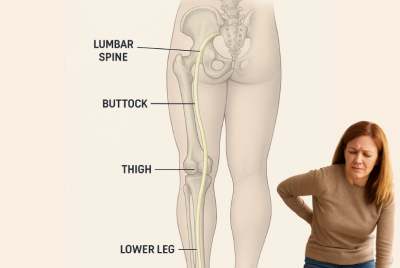How to Relieve Sciatic Nerve Pain
Discover effective strategies for how to relieve sciatic nerve pain naturally and improve your quality of life. Get relief now! Sciatic nerve pain can be debilitating, affecting your daily activities and overall quality of life. As someone who has dealt with sciatica personally and as an advisor on the topic, I understand the challenges it poses. In this article on how to relieve sciatic nerve pain, I’ll provide helpful suggestions and reasons for effectively managing and relieving sciatic nerve pain.
Introduction to Sciatic Nerve Pain
What is sciatic nerve pain?
Sciatic nerve pain, also known as sciatica, occurs when the sciatic nerve, which runs from the lower back down the back of each leg, is irritated or compressed. This leads to pain, numbness, tingling, or weakness in the lower back, buttocks, and legs.
Causes of sciatic nerve pain
Sciatica can be caused by various factors, including herniated discs, spinal stenosis, degenerative disc disease, or even pregnancy. In many cases, it’s a result of prolonged sitting, poor posture, or improper lifting techniques.
Importance of managing sciatic nerve pain
Effective management of sciatic nerve pain is crucial to improving mobility, reducing discomfort, and preventing further complications. Ignoring or neglecting the symptoms can lead to worsening pain and potential nerve damage over time.
Understanding the Symptoms
Sciatic nerve pain manifests differently for each individual, but common symptoms include sharp pain radiating from the lower back to the buttocks and down the leg, numbness or tingling sensation, and weakness in the affected leg. It can feel like a sharp, shooting pain or a constant ache, making it challenging to perform everyday tasks comfortably.
Diagnosis and Medical Guidance
It’s essential to seek medical guidance if you suspect you have sciatic nerve pain. A healthcare professional can perform a physical examination, review your medical history, and recommend diagnostic tests such as X-rays, MRI, or CT scans to accurately determine the underlying cause of your pain.
Lifestyle Changes for Relief
Importance of posture correction
Improving posture can alleviate pressure on the sciatic nerve. Avoid slouching and use ergonomic chairs or lumbar supports to maintain a neutral spine position.
Exercises for strengthening core muscles
Engaging in core-strengthening exercises can provide stability to the spine and reduce the risk of sciatic nerve compression. Focus on exercises that target the abdominal and lower back muscles.
Benefits of stretching exercises
Regular stretching exercises can improve flexibility and alleviate tension in the muscles surrounding the sciatic nerve. Incorporate gentle stretches for the hamstrings, piriformis, and lower back into your daily routine.
Alternative Therapies
Acupuncture and its benefits
Acupuncture involves inserting thin needles into specific points of the body to stimulate energy flow and promote pain relief. Many individuals find relief from sciatic nerve pain through acupuncture sessions.
Chiropractic care for sciatic nerve pain relief
Chiropractic adjustments can help realign the spine and alleviate pressure on the sciatic nerve. A chiropractor may use spinal manipulation techniques to improve mobility and reduce pain.
Managing Pain Through Medication
Over-the-counter pain relievers
Nonsteroidal anti-inflammatory drugs (NSAIDs) such as ibuprofen or naproxen can help reduce inflammation and alleviate sciatic nerve pain. Follow the recommended dosage and consult a healthcare professional if you have any concerns.
Prescription medications for severe pain
In severe cases of sciatic nerve pain, your doctor may prescribe muscle relaxants or stronger pain medications to manage symptoms effectively. These medications should be used under medical supervision to minimize side effects.
Heat and Cold Therapy
How heat therapy alleviates pain
Applying heat packs or taking warm baths can help relax tense muscles and improve blood flow to the affected area, reducing pain and stiffness associated with sciatic nerve pain.
Benefits of cold therapy for inflammation
Cold therapy, such as ice packs or cold compresses, can help reduce inflammation and numb the affected area, providing temporary relief from sciatic nerve pain. Alternate between heat and cold therapy for optimal results.
Ergonomic Adjustments
Importance of ergonomic furniture
Invest in ergonomic chairs, desks, and accessories designed to support proper posture and reduce strain on the spine. Adjust your workstation setup to maintain a neutral spine position and minimize pressure on the sciatic nerve.
Proper workstation setup to alleviate pressure on the sciatic nerve. Position your computer monitor at eye level, keep your feet flat on the floor, and use a chair with adequate lumbar support to maintain a healthy posture while sitting for extended periods.
Dietary Considerations
Foods that reduce inflammation
Incorporate anti-inflammatory foods such as fatty fish, leafy greens, berries, and nuts into your diet to help reduce inflammation and promote nerve health. Avoid processed foods and sugary snacks, which can exacerbate inflammation.
Importance of hydration for nerve health
Stay hydrated by drinking plenty of water throughout the day. Proper hydration is essential for maintaining healthy nerve function and reducing the risk of muscle cramps and stiffness associated with sciatic nerve pain.
Mind-Body Practices
Yoga and its benefits for sciatic nerve pain relief
Yoga combines physical postures, breathing exercises, and meditation techniques to improve flexibility, reduce stress, and alleviate sciatic nerve pain. Practice gentle yoga poses that focus on stretching and strengthening the back and leg muscles.
Meditation techniques to reduce stress and pain perception
Mindfulness meditation can help you manage stress and pain perception, making it easier to cope with sciatic nerve pain. Spend a few minutes each day practicing deep breathing and mindfulness exercises to promote relaxation and calmness.
Avoiding Triggering Activities
Activities to avoid aggravating sciatic nerve pain
Avoid activities that involve repetitive bending, lifting heavy objects, or prolonged sitting, as these can aggravate sciatic nerve pain and worsen symptoms. Listen to your body’s signals and take breaks as needed to prevent overexertion.
Importance of listening to your body’s signals
Pay attention to how your body responds to different movements and activities. If certain actions exacerbate your sciatic nerve pain, modify your behavior accordingly to prevent further discomfort and injury.
Pain Management Devices
TENS units for pain relief. Transcutaneous electrical nerve stimulation (TENS) units deliver low-voltage electrical impulses to the affected area, blocking pain signals and providing relief from sciatic nerve pain. Consult a healthcare professional before using a TENS unit to ensure safe and effective use.
Benefits of using lumbar supports
Lumbar supports, such as cushions or belts, can help maintain proper spinal alignment and reduce pressure on the sciatic nerve while sitting or driving for extended periods. Choose a lumbar support that fits your body comfortably and provides adequate support.
Sleeping Positions for Relief
Best sleeping positions for sciatic nerve pain
Sleeping on your side with a pillow between your knees can help align the spine and relieve pressure on the sciatic nerve. Avoid sleeping on your stomach, as this can strain the lower back and exacerbate sciatic nerve pain.
Importance of proper mattress and pillow selection
Invest in a firm mattress and supportive pillows that promote proper spinal alignment and reduce pressure points. Experiment with different sleeping surfaces to find the most comfortable option for relieving sciatic nerve pain.
Preventive Measures
Importance of maintaining a healthy weight
Excess weight can strain the lower back and exacerbate sciatic nerve pain. Maintain a healthy weight through regular exercise and a balanced diet to reduce pressure on the spine and prevent the recurrence of symptoms.
Regular exercise can help prevent the recurrence of sciatic nerve pain
Engage in low-impact exercises such as swimming, walking, or cycling to strengthen the muscles surrounding the spine and improve flexibility. Incorporate core-strengthening exercises into your routine to provide stability and support to the spine.
FAQs Related to How to Relieve Sciatic Nerve Pain
Can sciatic nerve pain go away on its own?
While mild cases of sciatic nerve pain may resolve on their own with rest and conservative treatment, chronic or severe cases often require medical intervention to manage symptoms effectively.
Is surgery necessary for treating sciatic nerve pain?
Surgery is typically considered as a last resort for treating sciatic nerve pain when conservative treatments fail to provide relief. Your healthcare provider will assess your condition and recommend the most appropriate treatment option based on your individual needs.
How long does it take to recover from sciatic nerve pain?
The recovery time for sciatic nerve pain varies depending on the underlying cause, severity of symptoms, and individual factors. With proper treatment and lifestyle modifications, many individuals experience significant improvement within a few weeks to months.
Can I still exercise with sciatic nerve pain?
Yes, gentle exercise and stretching can help alleviate sciatic nerve pain by improving flexibility, strengthening muscles, and reducing tension in the affected area. However, it’s essential to consult with a healthcare professional before starting any new exercise regimen to ensure it’s safe and appropriate for your condition.
Are there any long-term complications associated with sciatic nerve pain?
Untreated or poorly managed sciatic nerve pain can lead to long-term complications such as chronic pain, muscle weakness, and nerve damage. To prevent further complications and maintain optimal nerve health, it’s essential to seek medical attention and follow a comprehensive treatment plan.
How to Relieve Sciatic Nerve Pain – Conclusion
Managing sciatic nerve pain requires a comprehensive approach that effectively addresses the underlying causes and symptoms. Incorporating lifestyle changes, alternative therapies, and pain management strategies into your daily routine can alleviate discomfort, improve mobility, and enhance your overall quality of life.
Disclaimer
This article is for informational purposes only and is not a substitute for professional medical advice, diagnosis, or treatment. Always consult with your healthcare provider before starting a new exercise or stretching routine, especially if you have existing back or nerve conditions.
👉 Explore more:





